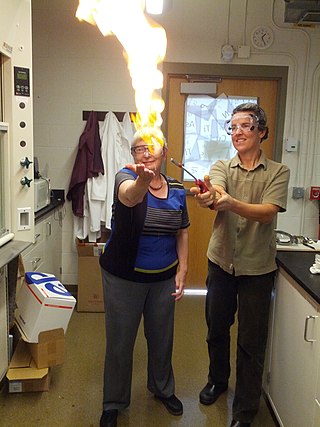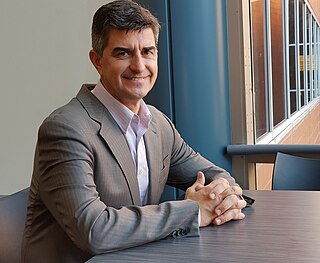
Pulickel Madhava Panicker Ajayan, known as P. M. Ajayan, is the Benjamin M. and Mary Greenwood Anderson Professor in Engineering at Rice University, Houston. He is the founding chair of Rice University's Materials Science and NanoEngineering department and also holds joint appointments with the Department of Chemistry and Department of Chemical and Biomolecular Engineering. Prior to joining Rice, he was the Henry Burlage Professor of Material Sciences and Engineering and the director of the NYSTAR interconnect focus center at Rensselaer Polytechnic Institute until 2007. Known for his pioneering work of designing and carrying out the first experiments to make nanotubes intentionally.

Chintamani Nagesa Ramachandra Rao,, is an Indian chemist who has worked mainly in solid-state and structural chemistry. He has honorary doctorates from 86 universities from around the world and has authored around 1,800 research publications and 58 books. He is described as a scientist who had won all possible awards in his field except the Nobel Prize.
Prashant V. Kamat is a professor of chemistry and biochemistry and a principal scientist of the radiation laboratory, University of Notre Dame. He is affiliated with the department of chemical and biomolecular engineering as a concurrent professor. He earned his master's (1974) and doctoral degree (1979) in physical chemistry from Bombay University, and carried out his postdoctoral research at Boston University (1979–1981) and University of Texas at Austin (1981–1983).
Gordon George Wallace is a leading scientist in the field of electromaterials. His students and collaborators have pioneered the use of nanotechnology in conjunction with organic conductors to create new materials for energy conversion and storage as well as medical bionics. He has developed new approaches to fabrication that allow material properties discovered in the nano world to be translated into micro structures and macro scopic devices.

Alexandra Navrotsky is a physical chemist in the field of nanogeoscience. She is an elected member of the United States National Academy of Sciences (NAS) and the American Philosophical Society (APS). She was a board member of the Earth Sciences and Resources division of the NAS from 1995 until 2000. In 2005, she was awarded the Urey Medal, by the European Association of Geochemistry. In 2006, she was awarded the Harry H. Hess Medal, by the American Geophysical Union. She is currently the director of NEAT ORU, a primary program in nanogeoscience. She was distinguished professor at University of California, Davis. Dr. Alexandra Navrotsky is currently a reagents professor back at Arizona State University, Tempe AZ. Her research group (TherMotU) investigate a fundamental thermodynamics as it relates to nanomaterials, geology, and material science.
Ayyappanpillai Ajayaghosh is a research scientist/academician in the domain of interdisciplinary chemistry, and the former Director of the National Institute for Interdisciplinary Science and Technology. He is known for his studies on supramolecular assemblies, organogels, photoresponsive materials, chemosensory and security materials systems and is an elected fellow of all the three major Indian science academies viz. the National Academy of Sciences, India, Indian National Science Academy and the Indian Academy of Sciences as well as The World Academy of Sciences. The Council of Scientific and Industrial Research, the apex agency of the Government of India for scientific research, awarded him the Shanti Swarup Bhatnagar Prize for Science and Technology, one of the highest Indian science awards for his contributions to Chemical Sciences in 2007. He is the first chemist to receive the Infosys Science Prize for physical sciences, awarded by the Infosys Science Foundation. He received the TWAS Prize of The World Academy of Sciences in 2013 and the Goyal prize in 2019.
Martina Heide Stenzel is a Professor in the Department of Chemistry at the University of New South Wales (UNSW). She is also a Royal Australian Chemical Institute (RACI) University Ambassador. She became editor for the Australian Journal of Chemistry in 2008 and has served as Scientific Editor and as of 2021, as Editorial Board Chair of RSC Materials Horizons.

Yury Georgievich Gogotsi is a scientist in the field of material chemistry, professor at Drexel University, Philadelphia, United States since 2000 in the fields of Materials Science and Engineering and Nanotechnology. Distinguished University and Trustee Chair professor of materials science at Drexel University — director of the A.J. Drexel Nanotechnology Institute.

Ganapati Dadasaheb Yadav is an Indian chemical engineer, inventor and academic, known for his research on nanomaterials, gas absorption with chemical reaction and phase transfer catalysis. He served as the vice chancellor of the Institute of Chemical Technology, Mumbai from 2009 until November 2019. He is currently the Emeritus Professor of Eminence at ICT Mumbai.
Murali Sastry is an Indian material chemist, nanomaterial scientist and the chief executive officer of the IITB-Monash Research Academy. He is a former chief scientist at Tata Chemicals and a former senior scientist at the National Chemical Laboratory. He is known for his studies on surfaces, films and materials chemistry and is an elected fellow of Maharashtra Academy of Sciences and the Indian Academy of Sciences. The Council of Scientific and Industrial Research, the apex agency of the Government of India for scientific research, awarded him the Shanti Swarup Bhatnagar Prize for Science and Technology, one of the highest Indian science awards, in 2002, for his contributions to chemical sciences.
Kakkudiyil George Thomas is an Indian photochemist, nanomaterial scientist and a professor at the Indian Institute of Science Education and Research, Thiruvananthapuram. He is known for his studies on photoresponsive nanomaterials and is an elected fellow of the Indian National Science Academy and the Indian Academy of Sciences. The Council of Scientific and Industrial Research, the apex agency of the Government of India for scientific research, awarded him the Shanti Swarup Bhatnagar Prize for Science and Technology, one of the highest Indian science awards, in 2006, for his contributions to chemical sciences.

Subramaniam Ramakrishnan is an Indian polymer chemist, a professor at the Department of Inorganic and Physical Chemistry http://ipc.iisc.ac.in/~rk/ and the designer at the Macromolecular Design and Synthesis Group of the Indian Institute of Science. He is known for his studies on design and synthesis of controlled polymer structures and is an elected fellow of the Indian Academy of Sciences. The Council of Scientific and Industrial Research, the apex agency of the Government of India for scientific research, awarded him the Shanti Swarup Bhatnagar Prize for Science and Technology, one of the highest Indian science awards, in 2005, for his contributions to chemical sciences.
Swapan Kumar Pati is an Indian quantum chemist, a professor of the department of chemistry at the Jawaharlal Nehru Centre for Advanced Scientific Research and the head of the Quantum Theory Molecules to Materials Group at the institute. He is known for his studies on electronic optical and magnetic phenomena in molecular systems and is an elected fellow of the Indian Academy of Sciences, National Academy of Sciences, India and The World Academy of Sciences. The Council of Scientific and Industrial Research, the apex agency of the Government of India for scientific research, awarded him the Shanti Swarup Bhatnagar Prize for Science and Technology, one of the highest Indian science awards, in 2010, for his contributions to chemical sciences.
Partha Sarathi Mukherjee is an Indian inorganic chemist and a professor at the Inorganic and Physical Chemistry department of the Indian Institute of Science. He is known for his studies on organic nano structures, molecular sensors and catalysis in nanocages. He is a recipient of the Swarnajayanthi Fellowship of the Department of Science and Technology and the Bronze Medal of the Chemical Research Society of India. The Council of Scientific and Industrial Research, the apex agency of the Government of India for scientific research, awarded him the Shanti Swarup Bhatnagar Prize for Science and Technology, one of the highest Indian science awards, in 2016, for his contributions to chemical sciences.
Lianzhou Wang is a Chinese Australian materials scientist and professor in the School of Chemical Engineering at the University of Queensland. He is director of the Nanomaterials Centre (Nanomac) and a senior group member at the Australian Institute for Bioengineering and Nanotechnology at the University of Queensland, as well as a Fellow of the Royal Society of Chemistry.

Katsuhiko Ariga is a Japanese chemist specializing in nanotechnology and self-assembly. He was educated at the Tokyo Institute of Technology, where he defended his PhD in 1990 and later worked as assistant professor. Since 2004 he carries out research at the National Institute for Materials Science, and teaches at the University of Tokyo, where he is a full professor. Ariga is a Fellow of the Royal Society of Chemistry (2013) and an editor of the journal Science and Technology of Advanced Materials.
Catherine Stampfl is a professor of physics at the University of Sydney and was elected as a Fellow of the Australian Academy of Science in 2019.

Ranjith Pathegama Gamage, a Fellow of the Australian Academy of Technology and Engineering, is an Australian academic based at Monash University, where he holds the position of Professor in Geomechanics Engineering. His research has significantly influenced understanding of the Carbon sequestration. He has also developed new sustainable technologies for extracting resources from deep earth and natural gas from coal seams, shale, and tight geological formations.
T Govindaraju is a professor in the Bioorganic Chemistry Laboratory at Jawaharlal Nehru Centre for Advanced Scientific Research, Bengaluru. The researchers in the Bioorganic Chemistry Laboratory work in areas which lie at the intersection of chemistry, biology and biomaterials science, and in particular, on problems related to Alzheimer's disease, peptide chemistry, molecular probes, molecular architectonics, nanoarchitectonics and biomimetics.
Ramasamy Ramaraj is an Indian physical chemist and a Professor of Eminence affiliated with the Department of Physical Chemistry at School of Chemistry of Madurai Kamaraj University (MKU). He is noted for his works on photoelectrochemistry and photoelectrocatalysis. He has also worked on chemically modified electrodes, artificial photosynthesis and solar energy conversion and nanomaterials. According to Stanford University's report in 2020, he was listed within the top 2% scientists in the world in his field of research.








